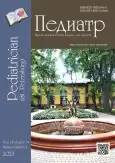Testing a new method for training medical doctors in percutaneous endoscopic gastrostomy in palliative pediatrics
- 作者: Gavshchuk M.V.1, Orel V.I.1, Bagaturiya G.O.1, Lisovskii O.V.1, Prudnikova M.D.1, Kosulin A.V.1, Vasilieva A.G.1
-
隶属关系:
- Saint Petersburg State Pediatric Medical University
- 期: 卷 14, 编号 4 (2023)
- 页面: 59-65
- 栏目: Original studies
- URL: https://journal-vniispk.ru/pediatr/article/view/232074
- DOI: https://doi.org/10.17816/PED14459-65
- ID: 232074
如何引用文章
详细
The main problem in training pediatric surgeons and endoscopists in the technique of performing percutaneous gastrostomy is associated with its relatively rare use in children, which in turn leads to a lack of consistent clinical practice among specialists, while percutaneous endoscopic gastrostomy (PEG) is considered the optimal method for correcting dysphagia in palliative pediatrics. A new method of training specialists in performing PEG in children is suggested. In an experimental operating setting, PEG procedures were performed on Chinchilla rabbits weighing 2.5–3.0 kg using a proprietary PEG placement kit with a 15 Fr tube size. Additionally, one PEG procedure was performed using reusable instruments and a 24 Fr Pezzer’s catheter, and four procedures were carried out with an 18 Fr Pezzer’s catheter using a specially developed tip for gastrostomy tube insertion. Flexible endoscopy with a 2.8 mm outer diameter, LED illumination, and an integrated visualization system was used for fibrogastroscopy. All stages of the procedure were practiced and studied through repeated repetitions. There was no significant difference in the technique of the procedure when applying PEG using a disposable proprietary kit versus using a Pezzer’s catheter with a special attachment. During the study, an original external fixation plate for securing the gastrostomy tube was developed and successfully used for 18 Fr Pezzer’s catheters. The size of the rabbits allows for training in all stages of PEG in pediatrics. The relative rarity of cases requiring gastrostomy in sick children hinders the training of PEG specialists. Theoretical training alone does not allow for acquiring the manual skills required to perform the procedure. Repeated performance of the procedure on animals enables the study of all stages of the operation, facilitates improvement of the technique, and the development of new devices and adaptations. The developed external fixation plate offers structural advantages compared to standard proprietary devices and will be in demand in clinical practice.
作者简介
Maksim Gavshchuk
Saint Petersburg State Pediatric Medical University
Email: gavshuk@mail.ru
ORCID iD: 0000-0002-4521-6361
Associate Professor, Department of General Medical Practice
俄罗斯联邦, Saint PetersburgVasiliy Orel
Saint Petersburg State Pediatric Medical University
Email: study@gpmu.org
ORCID iD: 0000-0001-6098-3449
MD, PhD, Dr. Sci. (Med.), Professor, Head, Department of Social Pediatrics and Public Health Organization AF and DPO
俄罗斯联邦, Saint PetersburgGeorgiy Bagaturiya
Saint Petersburg State Pediatric Medical University
Email: geobag@mail.ru
ORCID iD: 0000-0001-5311-1802
MD, PhD, Dr. Sci. (Med.), Professor, Head, Department of Operative Surgery and Topographic Anatomy named after Professor F.I. Walker
俄罗斯联邦, Saint PetersburgOleg Lisovskii
Saint Petersburg State Pediatric Medical University
Email: oleg.lisovsky@rambler.ru
ORCID iD: 0000-0002-1749-169X
MD, PhD, Cand. Sci. (Med.), Associate Professor, Head, Department of General Medical Practice
俄罗斯联邦, Saint PetersburgMaria Prudnikova
Saint Petersburg State Pediatric Medical University
编辑信件的主要联系方式.
Email: may.gpma@gmail.com
ORCID iD: 0000-0003-0863-1360
Assistant Lecturer, Department of General Medical Practice
俄罗斯联邦, Saint PetersburgArtem Kosulin
Saint Petersburg State Pediatric Medical University
Email: hackenlad@mail.ru
ORCID iD: 0000-0002-9505-222X
Assistant Lecturer, Department of Operative Surgery and Topographic Anatomy
俄罗斯联邦, Saint PetersburgAnastasia Vasilieva
Saint Petersburg State Pediatric Medical University
Email: vasilyeva-87@mail.ru
ORCID iD: 0000-0002-1515-3523
MD, PhD, Cand Sci. (Med.), Associate Professor, Department of Operative Surgery and Topographic Anatomy
俄罗斯联邦, Saint Petersburg参考
- Vorontsov IM, Mazurin AV. Propedevtika detskikh boleznei. 3rd edition. Saint Petersburg: Foliant, 2009. 1008 p. (In Russ.)
- Gavschuk MV, Gostimskii AV, Bagaturiya GO, et al. Import substitution possibilities in palliative medicine. Pediatrician (St. Petersburg). 2017;9(1):72–76. (In Russ.) doi: 10.17816/PED9172-76
- Gavshchuk MV, Gostimskii AV, Lisovskii OV, et al. Simulation training technique for performing percutaneous endoscopic gastrostomy. Grekov’s Bulletin of Surgery. 2020;179(6):50–54. (In Russ.) doi: 10.24884/0042-4625-2020-179-6-50-54
- Gavshchuk MV, Orel VI, Lisovskii OV, et al. Comparison of different gastrostomy methods according to objective criteria. University therapeutic journal. 2023;5(1):110–113. (In Russ.) doi: 10.56871/UTJ.2023.45.16.008
- Zavyalova AN, Gavshchuk MV, Novikova VP, et al. Analysis of cases of gastrostomia in children according to the data of the system of compulsory health insurance in Saint Petersburg. Nutrition. 2021;11(4): 15–22. (In Russ.) doi: 10.20953/2224-5448-2021-4-15-22
- Zavyalova AN, Gostimskii AV, Lisovskii OV, et al. Enteral nutrition in palliative medicine in children. Pediatrician (St. Petersburg). 2017;8(6):105–113. (In Russ.) doi: 10.17816/PED86105-113
- Kozlov YuA, Koval’skaya KA, Chubko DM, et al. The influence of laparoscopic gastrostomy on the development of gastroesophageal reflux — results of an experimental study. Russian Journal of Pediatric Surgery. 2017;21(3):116–120. (In Russ.) doi: 10.18821/1560-9510-2017-21-3-116-120
- Gauderer MWL, Ponsky JL, Izant RJ Jr. Gastrostomy without laparotomy. A percutaneous endoscopic technique. J Pediatr Surg. 1980;15(6):872–875. doi: 10.1016/S0022-3468(80)80296-X
- Minard G. The history of surgically placed feeding tubes. Nutr Clin Pract. 2006;21(6):626–633. doi: 10.1177/0115426506021006626
补充文件















